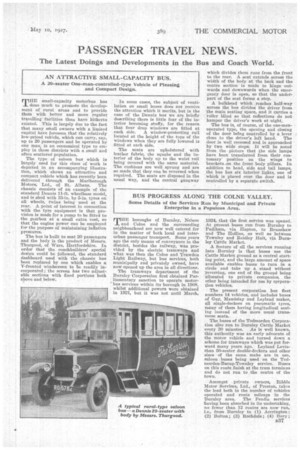PASSENGER TRAVEL NEWS.
Page 63

If you've noticed an error in this article please click here to report it so we can fix it.
The Latest Doings and Developments in the Bus and Coach World.
AN ATTRACTIVE SMALL-CAPACITY BUS.
A 20-seater One-man-controlled-type Vehicle of Pleasing and Compact Design.
THE small-capacity motorbus has done much to promote the development of rural areas and to provide them with better and more regular travelling facilities than have hitherto existed. This is largely due to the fact that many small owners with a limited capital have foreseen that the relatively low-priced vehicle, which can carry, say, up to 20 passengers and be operated by one man, is an economical type to employ in those districts with a small and often scattered population.
The type of saloon bus which is largely used for this class of work is depicted in an accompanying illustration, which shows an attractive and compact vehicle which has recently been delivered through the Marlborough Motors, Ltd., of St. Albans. The chassis consists of an example of the standard Dennis 11-ft. wheelbase model, and is shod with 33-in. by 5-in. tyres on all wheels, twins being used at the rear. A point of interest in connection with the tyre equipment is that provision is made fer a pump to be fitted to the gearbox at a small extra cost, so that the engine power can be employed for the purpose of maintaining inflation pressures.
The bus is built to seat 20 passengers and the body is the product of Messrs. Thurgood, of Ware, Hertfordshire. In order that the coaehbuilders' special design could be followed, the standard dashboard used with the chassis has been replaced by one which enables a V-fronted windscreen to be readily incorporated; the screen has two adjustable sections with fixed portions both above and below.
In some cases, the subject of ventilation on small buses does not receive the attention which it merits, but in the case of the Dennis bus we are briefly describing there is little fear of the interior becoming stuffy, for the reason that four drop windows are fitted at each side. A window-protecting rail located at the height of the tops of the windows when they are fully lowered is fitted at each side.
The seats are upholstered with leather fabric, the squabs and the interior of the body up to the waist rail being covered with the same material. The cushions are well sprung and are so made that they can be reversed when required. The seats are disposed in the usual way, and the central gangway which divides them runs from the front to the rear. A seat extends across the width of the body at the back and the centre section is made to hinge outwards and downwards when the emergency door is open, so that the underpart of the seat forms a step.
A bulkhead which, reaches half-way across the bus divides the driver from the main seating space, and it carries a roller blind so that reflections do not hamper the driver's work at night.
The bus is, of course, of the one-manoperated type, the opening and closing of the door being controlled by a lever close to the driver's left hand. The door is well recessed and is approached by two wide steps. It will be noted from the picture that the side lamps have been transferred from their customary position on the wings to brackets on the, front body pillars. In addition to head, side and tail lamps, the bus has six interior lights, one of which is placed over the door and is controlled by a separate switch.




















































































































